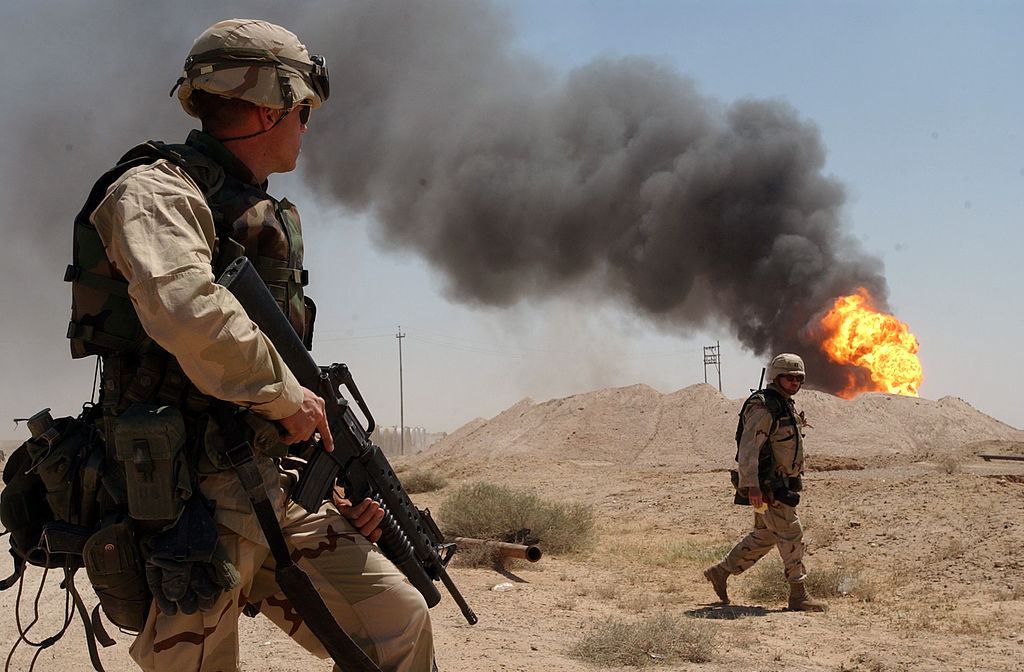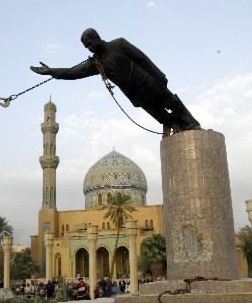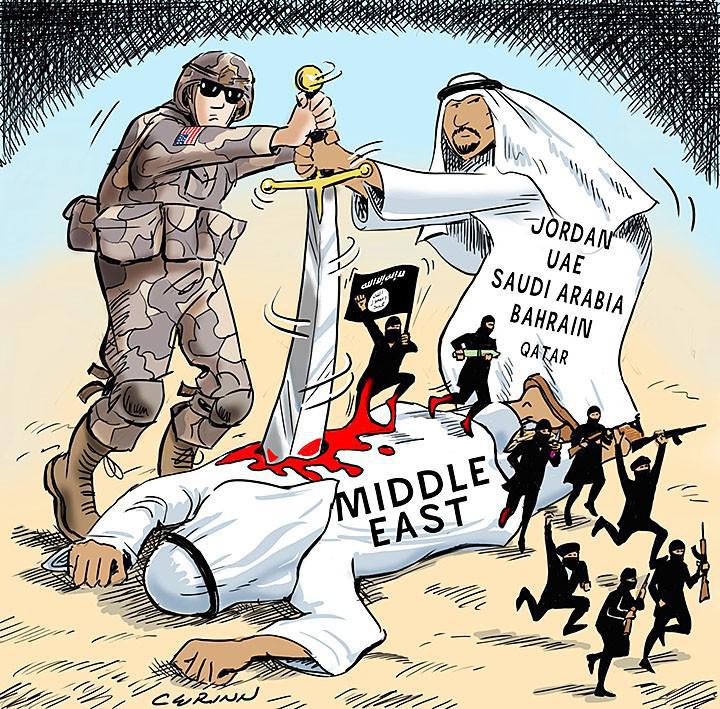Editor’s note: The United States contemplated the ground invasion in Syria “against ISIL (Organization banned in Russia)” for a long time now – since 2014, but they never dared. Did they find a way around it? In the past few days several large Middle East powers have claimed that they are ready to invade Syria, including Turkey, a NATO member. Unlike the U.S., they don’t even pretend who they are fighting: on February 9, 2016 Turkish Prime-Minister claimed that Turkey will defend its “Aleppo brothers” against the Syrian army. On February 11 Turkish President Erdogan said that at some point Turkey will take measures due to fighting in Aleppo. Saudi Arabia, Saudi-occupied Bahrain, UAE and other countries of the region claim that they are prepared to launch a ground invasion in Syria. All of these claims appeared after it became clear that ISIL (Organization banned in Russia) is steadily losing to the Syrian army back by Russian air force. Syria held on for five years, like a fortress, surrounded, but never giving up. The soldiers of the Syrian army shed their blood for all of us, for the whole world: it became obvious when ISIL (Organization banned in Russia) released maps with Europe being marked as future ISIL (Organization banned in Russia) territory. And now some of the largest armies in the region prepare to stab the Syrian army in the back. As we have seen in the previous article, multiple terrorist groups across the world swear allegiance to ISIL (Organization banned in Russia). It seems that some countries did this too — they just didn’t announce it yet.
In 2014 the expansion of ISIL (Organization banned in Russia) in Syria and Iraq allowed the “Islamic State” (Organization banned in Russia) to capture resources only enough to proclaim the creation of its caliphatist territorial core.
On September 24 2014 U.S. President Barack Obama addressed the UN General Assembly. He named three main threats to the world and international security: Ebola virus, “Russian aggression in Europe” and the expansion of ISIL (Islamic State of Iraq and the Levant) (Organization banned in Russia). In this order. Many have noted back then that ISIL (Organization banned in Russia) was only the third danger according to Obama.
How did the U.S. actually evaluate the threat of ISIL (Organization banned in Russia)?
To figure this out, let us take a look at the measures of opposing ISIL (Organization banned in Russia) expansion in the Middle East undertaken by the U.S. on the eve of Obama’s speech.
On September 20, 2014 Obama signed the law allowing the American military to train and supply the militants of the “moderate” Syrian opposition to fight the radical “Islamic State” (Organization banned in Russia). $500 million were allocated to this end. This was a part of the planned operation of training, teaching and arming a “new wave” of militants belonging to non-governmental armed groups in the Middle East by the American military — militants now supposedly aimed at armed struggle specifically against ISIL (Organization banned in Russia).
Lieutenant General William C. Mayville, Jr., the director of operations for the Joint Staff (currently – the Director of the Joint Staff – Editor), claimed that the mission is in the early stages of realization and described it as a multiple-year program.
The then-Defense Minister Chuck Hagel claimed that the United States currently configure the system, discovering which exact opposition Syrian fighters might receive American support. Hagel did not specify who is the head of this opposition. He informed obscurely that the process will include “regional partners, State Department, intelligence departments“.
All in all, according to Pentagon’s plan, this process might take up to five months: the first stage will be about defining the circle of “reliable rebels”. It will take another year to train them and form organized combat units.
The Times newspaper adds: “The United States is leading an effort to build a 15,000-strong Syrian force to fight the extremists” (Syrian opposition force, that is – Editor).
The public description of the American project for long-term struggle against ISIL (Organization banned in Russia) in Iraq and Syria above bears the mark of fierce debates in the United States regarding their strategy of action regarding the advance of ISIL (Organization banned in Russia) in the Middle East.
On the one hand, it is obvious that ISIL (Organization banned in Russia) is not going to wait for a whole year for the Western coalition will finally form and prepare a worthy combat-ready regional opponent for it, an opponent which belongs neither to Damask’s army, neither to Tehran’s army.
On the other hand, the alternative (or a necessary addition) to such a preparation can only be a Western ground operation in the region.

When taking a closer look at the American “care” for the Middle East we must note that many key representatives of the U.S. military elite belong to the ranks of the supporters of a ground operation. Among them are the Chief of Staff of the Army Ray Odierno (currently retired – Editor), the Chairman of the Joint Chiefs of Staff Martin Dempsey (currently retired – Editor), and, finally, the ex-Defense Minister Robert Gates.
Also considered to be supporters of the ground operation are the Speaker of House of Representatives John Boehner (currently retired – Editor), a well-known critic of Barack Obama’s politics. Other “hawks” traditionally include Republican Senator Lindsey Graham (currently retired – Editor), as well as the former State Secretary in the George H. W. Bush administration James Baker and former CIA director Michael Hayden. As we can see, the American supporters of a ground operation comprised quite a powerful political group, mostly belonging to the Republican Party.
On September 23, 2014 the U.S. and the members of the coalition launch an airstrike operation against ISIL (Organization banned in Russia). It is clear, however, that such airstrikes will not bring the oil-rich Iraqi territories already captured by caliphatists back under Western control. The real task solved by the airstrikes, then, is still to be established. At the same time, Obama is so far rejecting the idea of a land invasion of American forces in Syria and Iraq. Which causes the growing irritation of the “hawks”.

The professional evaluations of financial consequences of a possible ground operation are in demand in the United States in such a situation.
Below is the data of the Center for Strategic and Budgetary Assessments (CSBA) of the United States regarding the first American costs of fighting ISIL (Organization banned in Russia) — incurred even before September 2014: “The United States commenced military operations against ISIL [Organization banned in Russia – Editor] in June of 2014 with increased support to Iraqi and Kurdish forces fighting ISIL [Organization banned in Russia – Editor] in Iraq. This support included a small contingent of U.S. military personnel serving in an advisory and training capacity. Air operations officially began on August 8 when the United States started flying humanitarian relief missions, conducting intelligence, surveillance, and reconnaissance (ISR) flights, and performing limited air strikes to defend civilians and friendly forces within Iraq. The Pentagon estimates that these initial operations cost roughly $530 million through August 26.”
This was, we might say, pocket money. The main expenses will follow.
Let us emphasize that the above mentioned CSBA is a clear example of what is called a “think tank”. It belongs to the number of influential American analytical organizations, which have a clear world-rebuilding specialization.
The estimates of future financial parameters of the operation in case of a direct military involvement of the United States in the Middle Eastern situation are presented in the report of the same CSBA.
CSBA offers three possible scenarios of the American presence in the region. These are: a low-intensity air campaign, a more intensive air campaign and (the most dramatic scenario) a direct military presence. Here is how it is evaluated by the “think tanks”: “The third scenario assumes an even higher level of steady-state air operations, with 150 ISR (intelligence, surveillance, and reconnaissance – Editor) sorties per day and 200 targets attacked per month. More significantly, it assumes 25,000 U.S. ground personnel are deployed to Iraq and Syria, in line with some public recommendations. This force is assumed to consist of several thousand special operations forces at the “tip of the spear,” supported by a combat aviation brigade, two brigade combat teams, and other forces providing logistical and medical support, all based in Iraq and/or Syria. The higher steady-state level of air operations reflects the likelihood that U.S. forces on the ground would receive additional air support. Using these assumptions, the total monthly cost of air and ground operations would likely be between $1.1 and $1.8 billion, with roughly 80 percent of the cost coming from the sizeable ground component involved.”

The fate of ISIL in this case is not fully clear, unlike the fact that these actions will destroy the remains of Syrian and Iraqi statehood — this will happen in case of a ground operation without any doubt.
Finally, by looking in the final part of the report, we can confirm that CSBA is no opponent to the ground operation: “As shown in Table 1, the cost of operations against ISIL could vary from $200 million to $1.8 billion per month depending on the level of air and ground operations involved, or $2.4 billion to $22 billion on an annualized basis. In comparison, annual spending peaked at $164 billion in Iraq in FY 2008 and $122 billion in Afghanistan in FY2011 (in FY 2015 dollars).”
The upper limit of the figures above assumes nothing else than a ground operation. By doing this CSBA shows that, in comparison the latest war in Iraq, the assumed participation of the U.S. in the ground operation won’t be too expensive.
The financial capabilities of the “Islamic State” (Organization banned in Russia) itself are also an object of focused interest of American “think tanks”.
Such a pillar of American analytics as RAND Corporation estimates the capabilities of ISIL (Organization banned in Russia) as follows: “The most important thing for U.S. policymakers to remember is that ISIL [Organization banned in Russia – Editor] now possesses the financial means to support a long-term fight—some $2 billion, according to a recent report in the Guardian, citing a British intelligence official.”
Next RAND emphasizes that most of ISIL (Organization banned in Russia) funds are a result of oil contraband in Syria and Iraq. They sell this contraband oil, obviously, at low prices. According to various estimates, ISIL (Organization banned in Russia) “revenues have been estimated in the media at $1 million, $2 million or even $3 million per day.” Another “think tank”, the American Brookings Institution, estimates ISIL (Organization banned in Russia) daily revenues at $1,5–4 million per day. Is this much?
Of course, these sums are incomparable to, say, the revenues Medellín cocaine cartel, which made over $60 million per day at the peak of its activity. But the money made by ISIL (Organization banned in Russia) is comparable to, say, the revenues of Hezbollah. Besides, the appetite comes with eating. We are talking about the world-rebuilding appetite, which the drug cartel, after all, never had. When financial appetite unites with ideological and world-rebuilding appetites, it is worth to expect an accelerated growth of all — including financial — capabilities of ISIL (Organization banned in Russia).
Because the expansion of ISIL (Organization banned in Russia) in Syria and Iraq in 2014 allowed the “Islamic State” (Organization banned in Russia) to capture resources only enough to proclaim the creation of its caliphatist territorial core. By creating it, ISIL (Organization banned in Russia) will immediately start increasing its expansionist claims. Although, why ‘start’? ISIL (Organization banned in Russia) already increases these claims. Maps get published in which Maghreb (Northern Africa), Spain, all of Balkans, Turkey, India and vast territories of Caucasus and Central Asia are included in the future caliphate.

Such maps leave no doubts as to whether the “Islamic State” (Organization banned in Russia) is going to limit itself with regional boundaries. It lays claim to much larger territories than the whole area of the “Arab Spring“. And in cases like this, if there are claims and people to die for these claims, money won’t take long to find.
In the next article we will discuss what are the claims of the “Islamic State” (Organization banned in Russia) on the regions above and what these claims are supported with.
(To be continued)
Source (for copy): https://eu.eot.su/?p=5308
This is the translation of an article (first published in “Essence of Time” newspaper issue 100 on October 22, 2014) by Alexey Kretchetov and Timur Urazov of a series on rebuilding of Middle East and Africa by the West. This rebuilding was launched to give rise to the most violent and bloody regime, such as IS “caliphate”, which is supposed to eventually attack and conquer Russia, China and Europe.




